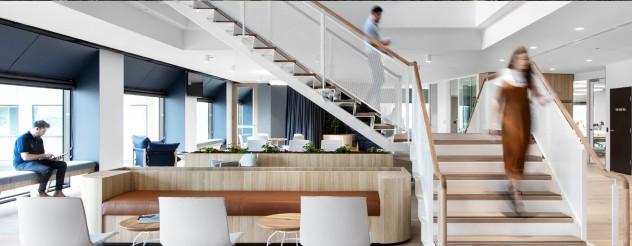
- Home
- VHBA In Brief: December 2023
Welcome to VHBA In Brief
Welcome to a special edition of the Victorian Health Building Authority (VHBA) newsletter, VHBA In Brief.
In our 2023 wrap-up, we celebrate these major health infrastructure projects that were delivered over the past 12 months:
- Victorian Heart Hospital
- Statewide Child and Family Centre
- Wyndham Early Parenting Centre
- New mental health beds at Sunshine Hospital, Northern Hospital and Royal Melbourne Hospital.
Thank you for joining us in building a healthier future for Victorians this year. We hope you can join us again in 2024.
Subscribe to our mailing list to keep up to date on our announcements and project updates.
Australia's first cardiac hospital has research at heart
The $577 million Victorian Heart Hospital opened in early 2023.
The new hospital is home to the state's leading cardiac specialists and researchers. It provides life-saving diagnosis and treatment for thousands of patients each year.
The hospital won a 2023 INDE.Award for best design in the Health and Wellbeing Space.
How was the Victorian Heart Hospital built to innovate?
Accessible transcript
IMAGES: View upward from the ground of a section of the hospital, followed by an aerial view of the hospital and surrounding suburb, and view upward of the upper level of the hospital.
VOICEOVER: We're really excited. This is the first standalone heart hospital in the country. The only one of its type in the southern hemisphere.
IMAGES: Professor Nicholls speaking in a conference room of the hospital.
VOICEOVER: This has been an extraordinary journey. My colleagues started to think about a dedicated heart facility probably about a decade ago.
IMAGES: A tracking shot across a section of the hospital façade.
ONSCREEN TEXT: How is research embedded in the hospital?
IMAGES: Professor Nicholls speaking in a conference room of the hospital, followed by view upward of the upper level of the hospital.
VOICEOVER: This project is completely about innovation. We're not just building a heart hospital. We're putting a heart hospital on a university campus.
IMAGES: Professor Nicholls and a colleague talking, silhouetted against a large viewing window, then walking along a corridor flanked by work benches, followed by a view of a research laboratory.
VOICEOVER: We're embedding our research. It brings our researchers close to our patients and our clinicians to be able to make new discoveries, new inventions. We can bring those inventions to the clinic much faster.
IMAGES: Professor Nicholls speaking in a conference room of the hospital.
VOICEOVER: It's important for our researchers. It's important for our patients because it means that our patients will have access to cutting-edge treatments.
IMAGES: An operating theatre, followed by a CT scanner.
VOICEOVER: There are some patients with heart disease where there are no treatments that can help them. We need new solutions.
IMAGES: Professor Nicholls speaking in a conference room of the hospital, followed by doors opening into an operating theatre.
VOICEOVER: If I was a patient in this hospital, there's an incredible opportunity to be involved in clinical trials, new ways of delivering the care that we already have.
ONSCREEN TEXT: A national training hub.
IMAGES: Lights within an operating theatre, followed by a tracking shot moving down a section of a research laboratory.
VOICEOVER: We have an opportunity to be the epicentre for teaching and training the next generation. and they're not just doctors. We're talking about nurses, physiotherapists, dietitians, genetic counsellors, you name it. This is going to be the national hub for where we're going to train people.
IMAGES: An operating theatre, followed by a lecture theatre and research laboratory.
VOICEOVER: Whether it's operating somebody in one of our operating theatres, or putting a new heart valve in one of our interventional cath labs. We can have people sitting our lecture theatres, our meeting rooms watching that, and then we can quickly decamp out into teaching areas and debrief and talk about what we just saw and why that's important.
IMAGES: Research laboratory.
VOICEOVER: We can simulate a whole bunch of new interventional procedures to use across the region, work closely with industry where we know that kind of simulation training is increasingly important.
ONSCREEN TEXT: How will you innovate future treatments?
IMAGES: aerial view tracks across the hospital, followed by close up of theatre lighting.
VOICEOVER: We see this whole building for us being a smaller part of Monash Health. It's not just about innovation from a research and teaching perspective. It really allows for us to innovate the way that we simply just look after our patients on a day-to-day basis.
IMAGES: Upward view of façade of section of the hospital.
VOICEOVER: It’s fundamentally about the patient. We want people home and well and live the lives they want to live.
IMAGES: Frame with ‘In partnership with Monash Health (logo) and Monash University (logo)’.
IMAGES: The closing slide is the Victorian Health Building Authority logo, the web address vhba.vic.gov.au and the Victorian State Government logo.
End of transcript.

In the spotlight
New Statewide Child and Family Centre a Victorian first
The $7.3 million, 12-bed centre is a Victorian first and supports children aged 0-11 years.
The centre is unique. Children can stay with their families while they are receiving mental health care from specialist clinicians.
Statewide Child and Family Centre - First look
Accessible transcript
IMAGES: An image of the exterior of the facility, showing the freshly planted garden
Text: A new 12-bed facility offering dedicated mental health support and treatment for children and their families
IMAGES: Chairs with children’s plush toys
Text: Delivering vital residential mental health and wellbeing treatment to children
IMAGES: Camera pans across a living room; cuts to a large table with chairs
Text: in an environment that allows them to stay with and be supported by their families
IMAGES: Cuts to one of the bedrooms
Text: Featuring private rooms and shared living spaces
IMAGES: Camera pans across the large communal kitchen
Text: including a communal kitchen, dining, lounge,
IMAGES: an image of the laundry room; cuts to a family activity area filled with toys
Text: laundry and family activity areas
IMAGES: cuts to a montage of shots of the garden area
Text: outdoor gardens,
IMAGES: an image of a private room with a table and chairs
Text: along with clinical consulting spaces.
IMAGES: a montage of the kitchen and dining spaces
Text: The facility will provide 24-hour care and support for children and their families
IMAGE: A sliding transition screen displays the Victorian Health Building Authority and Victoria State Government logos and the web address vhba.vic.gov.au
End of transcript
Construction on the new Wyndham Early Parenting Centre is complete
Families with children up to four years old can access support in Melbourne’s south-west.
It is the first of nine new early parenting centres to open its doors in Victoria. Specialists at the centres will help build parenting skills and improve parent-child relationships.
Explore the new Wyndham Early Parenting Centre.
Accessible transcript
Text on screen: Construction is complete on the new, multi-million dollar Wyndham Early Parenting Centre
Images: aerial footage of the completed centre seen in its suburban setting, and from directly above
Text on screen: It is the first of nine new Early Parenting Centres to open its doors in Victoria
Images: front entry of the building with sign directing to reception, deliveries and car parking
Text on screen: Take a look inside
Images: a child’s wooden block train on a tabletop
Text on screen: Early parenting centres support parents and caregivers with babies and toddlers from 0-4 years old
Images: view past reception base down corridor to consulting rooms, followed by close-up of sign reading ‘pram parking’
Text on screen: The centres help build parenting skills, from enhancing parent-child relationships to providing support with:
Images: large meeting room with artwork across several wall spaces, a large screen, chairs and children’s play activity equipment. On screen text reads ‘Artwork by Kobi Sainty’
Text on screen: sleep, settling or feeding; bonding, developmental milestones, adjusting to parenthood and building parenting skills
Images: child’s bedroom with cot and feeding chair; close-up of activity play equipment in a meeting room; outdoor playground equipment and various couches with child’s table setting and toy train plus onscreen text ‘Artwork by Kobi Sainty’
Images: aerial footage of the new centre in its suburban setting
Images: A sliding transition screen displays the Victorian Health Building Authority and Victoria State Government logos and the text ‘learn more at vhba.vic.gov.au’
End of transcript.

Project pulse
More 2023 milestones:
- Mental Health Beds Expansion Program: Increased capacity at Sunshine Hospital, Northern Hospital and Royal Melbourne Hospital
- Maryborough and District Hospital: Work underway at $115 million redevelopment
- Kingston Centre: Work underway on $134.6 million residential aged care facility
- Wonthaggi Hospital: Upgraded hospital opens its doors
- New Footscray Hospital: The $1.5 billion project towers reach maximum height
- Frankston Hospital: Structural works underway on $1.1 billion redevelopment

In the works

Procurement
Recently published:
We encourage suppliers to register on Buying for Victoria (tenders.vic.gov.au) and the Industry Capability Network to view VHBA offers to supply.
Find out more about VHBA procurement.
Careers
Keen to shape the future of healthcare in Victoria in 2024? We're looking for:
- Digital Content Officer (VPSG4)
- Administration Officer (VPSG3)
Find out more or apply on the Careers Vic website.

Keep up with our announcements on health, mental health and aged care projects by signing up to our online newsletters.
Related content

17 February 2025
VHBA In Brief: Read our newsletters
View past editions of our e-newsletter, VHBA In Brief.
02 November 2023
VHBA In Brief: November 2023
In this issue: Sunshine Mental Health and Wellbeing Centre now open, Crane named after Frankston Hospital Pink Ladies volunteers, Wyndham Early Parenting Centre complete.
23 October 2025



